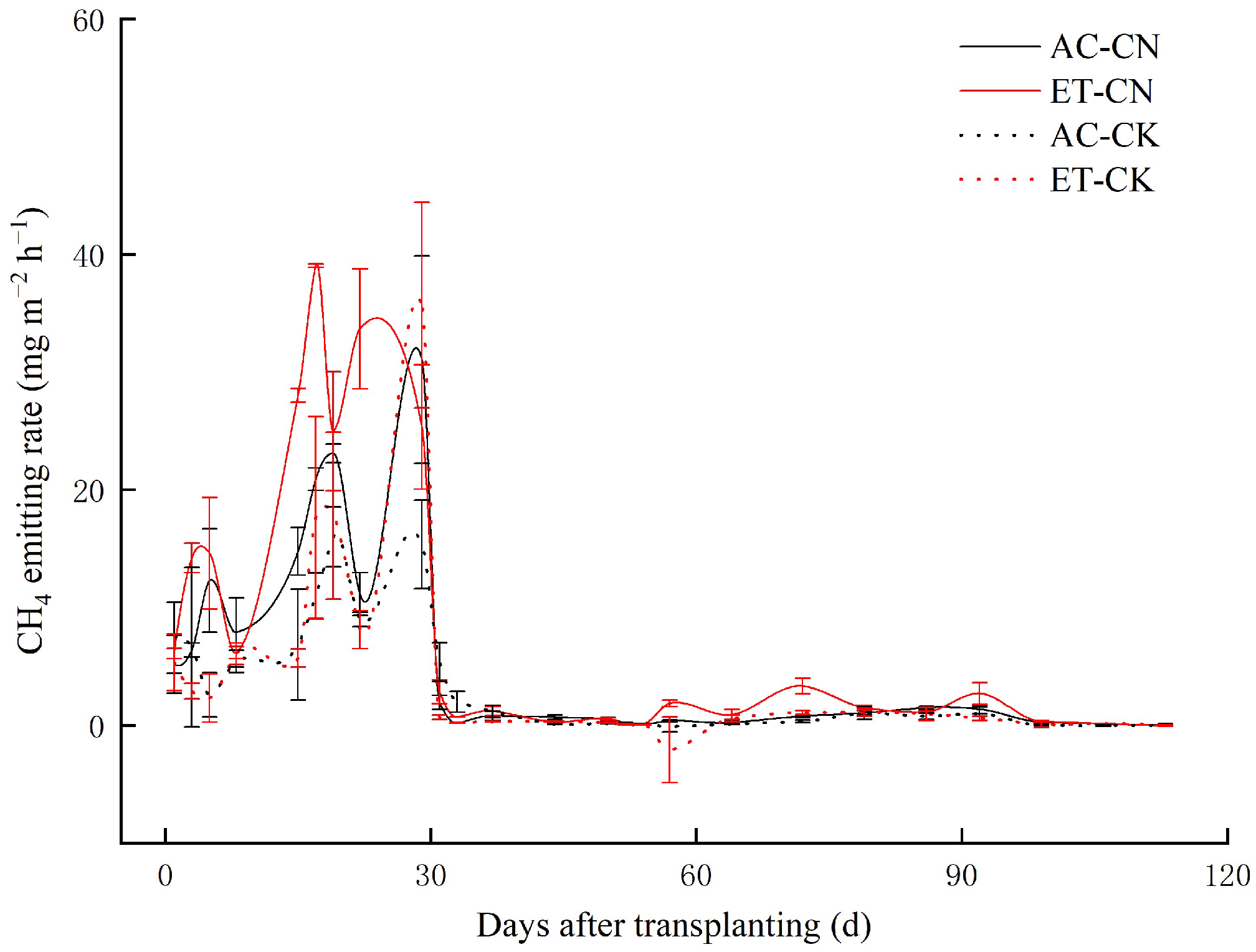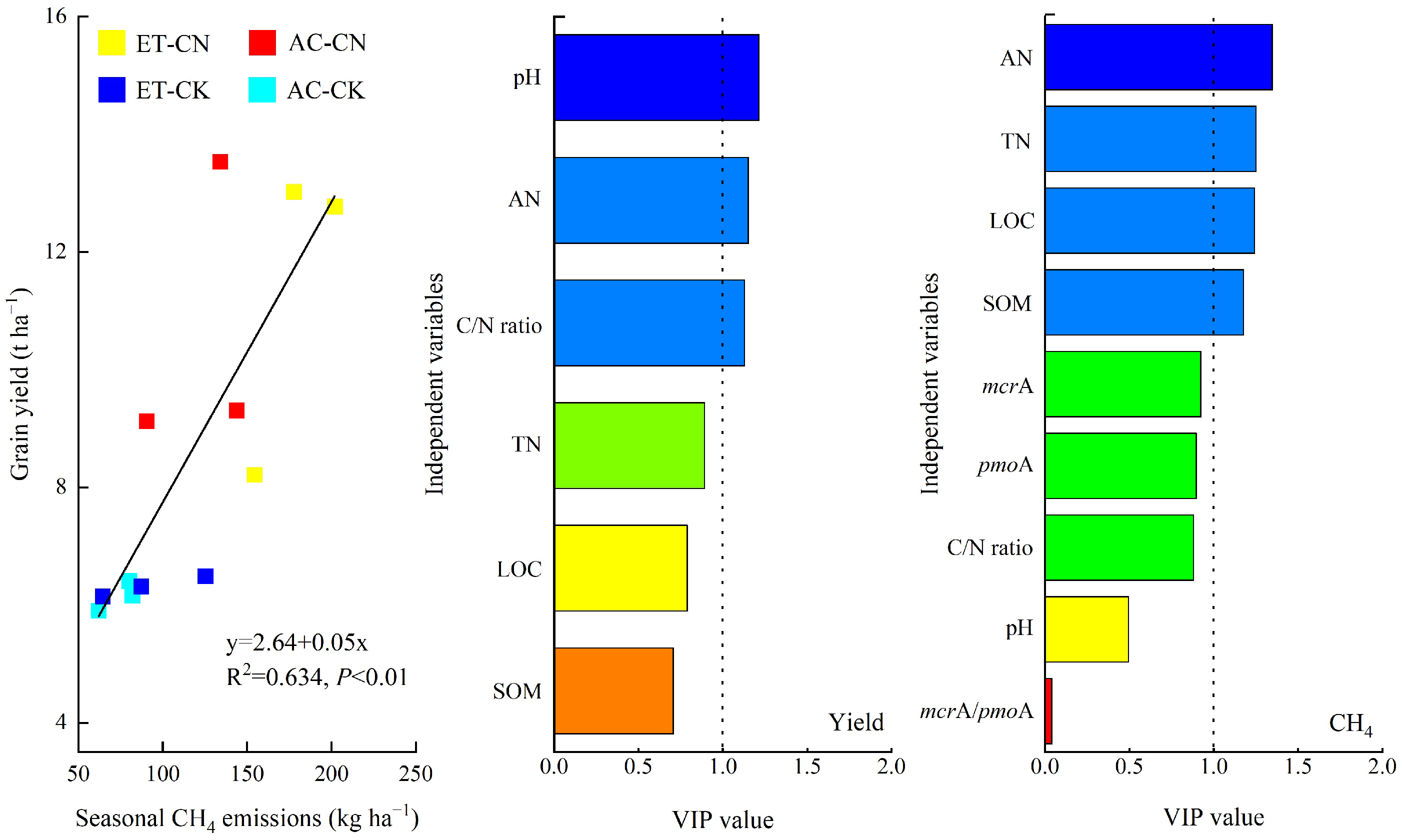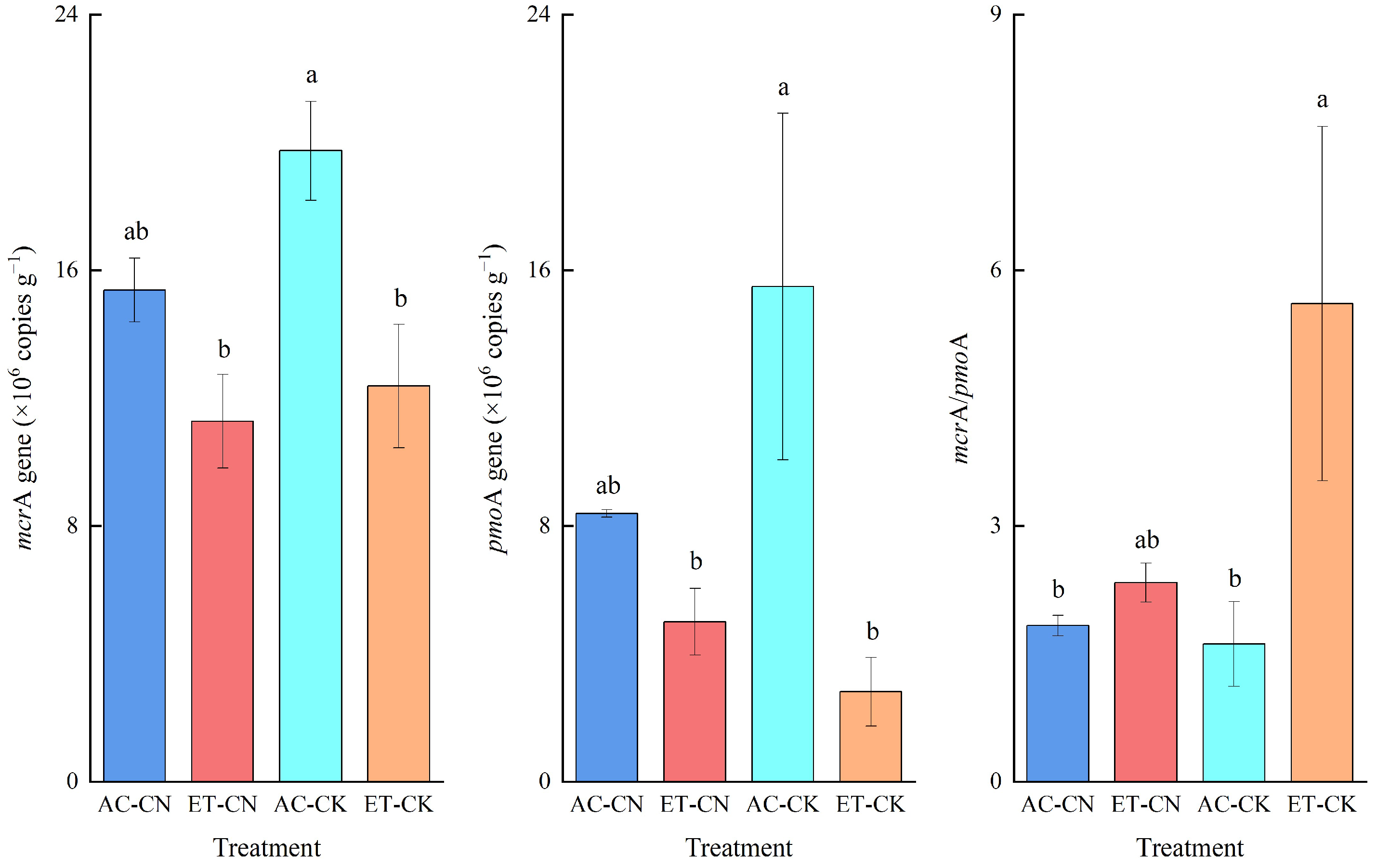Fertilization and Global Warming Impact on Paddy CH4 Emissions
Abstract
1. Introduction
2. Materials and Methods
2.1. Experiment Site
2.2. Experimental Design
2.3. Sampling and Measurement
2.4. Statistical Analysis
3. Results
3.1. CH4 Emissions
3.2. Grain Yield and CH4 Emissions
3.3. Soil Fertility
3.4. Abundance of Soil Fuctional Microbial Genes
4. Discussion
4.1. Rice Yield
4.2. CH4 Emissions
5. Conclusions
Author Contributions
Funding
Informed Consent Statement
Data Availability Statement
Conflicts of Interest
References
- Lynch, J.; Cain, M.; Frame, D.; Pierrehumbert, R. Agriculture’s contribution to climate change and role in mitigation is distinct from predominantly fossil CO2-emitting sectors. Front. Sustain. Food Syst. 2021, 4, 518039. [Google Scholar] [CrossRef] [PubMed]
- Carlson, K.M.; Gerber, J.S.; Mueller, N.D.; Herrero, M.; MacDonald, G.K.; Brauman, K.A.; Havlik, P.; O’Connell, C.S.; Johnson, J.A.; Saatchi, S.; et al. Greenhouse gas emissions intensity of global croplands. Nat. Clim. Chang. 2017, 7, 63–68. [Google Scholar] [CrossRef]
- Liu, S.; Zheng, Y.; Ma, R.; Yu, K.; Han, Z.; Xiao, S.; Li, Z.; Wu, S.; Li, S.; Wang, J.; et al. Increased soil release of greenhouse gases shrinks terrestrial carbon uptake enhancement under warming. Glob. Chang. Biol. 2020, 26, 4601–4613. [Google Scholar] [CrossRef]
- IPCC. Climate Change 2021: The Physical Science Basis. Contribution of Working Group I to the Sixth Assessment Report of the Intergovernmental Panel on Climate Change; Cambridge University Press: Cambridge, UK, 2021. [Google Scholar]
- Wang, C.; Jin, Y.; Ji, C.; Zhang, N.; Song, M.; Kong, D.; Liu, S.; Zhang, X.; Liu, X.; Zou, J.; et al. An additive effect of elevated atmospheric CO2 and rising temperature on methane emissions related to methanogenic community in rice paddies. Agric. Ecosyst. Environ. 2018, 257, 165–174. [Google Scholar] [CrossRef]
- Wang, H.; Yang, T.; Chen, J.; Bell, S.M.; Wu, S.; Jiang, Y.; Sun, Y.; Zeng, Y.; Zeng, Y.; Pan, X.; et al. Effects of free-air temperature increase on grain yield and greenhouse gas emissions in a double rice cropping system. Field Crops Res. 2022, 281, 108489. [Google Scholar] [CrossRef]
- Qian, H.; Zhang, N.; Chen, J.; Chen, C.; Hungate, B.A.; Ruan, J.; Huang, S.; Cheng, K.; Song, Z.; Hou, P.; et al. Unexpected parabolic temperature dependency of CH4 emissions from rice paddies. Environ. Sci. Technol. 2022, 56, 4871–4881. [Google Scholar] [CrossRef]
- Kong, D.; Li, S.; Jin, Y.; Wu, S.; Chen, J.; Hu, T.; Wang, H.; Liu, S.; Zou, J. Linking methane emissions to methanogenic and methanotrophic communities under different fertilization strategies in rice paddies. Geoderma 2019, 347, 233–243. [Google Scholar] [CrossRef]
- Malyan, S.K.; Bhatia, A.; Kumar, A.; Gupta, D.K.; Singh, R.; Kumar, S.S.; Tomer, R.; Kumar, O.; Jain, N. Methane production, oxidation and mitigation: A mechanistic understanding and comprehensive evaluation of influencing factors. Sci. Total Environ. 2016, 572, 874–896. [Google Scholar] [CrossRef]
- Li, S.; Chen, Y.; Yu, F.; Zhang, Y.; Liu, K.; Zhuo, X.; Qiu, Y.; Zhang, H.; Gu, J.; Wang, W.; et al. Reducing methane emission by promoting its oxidation in rhizosphere through nitrogen-induced root growth in paddy fields. Plant Soil 2022, 474, 541–560. [Google Scholar] [CrossRef]
- Bhattacharyya, P.; Roy, K.S.; Neogi, S.; Dash, P.K.; Nayak, A.K.; Mohanty, S.; Baig, M.J.; Sarkar, R.K.; Rao, K.S. Impact of elevated CO2 and temperature on soil C and N dynamics in relation to CH4 and N2O emissions from tropical flooded rice (Oryza sativa L.). Sci. Total Environ. 2013, 461–462, 601–611. [Google Scholar] [CrossRef]
- Hopkins, F.M.; Filley, T.R.; Gleixner, G.; Lange, M.; Top, S.M.; Trumbore, S.E. Increased belowground carbon inputs and warming promote loss of soil organic carbon through complementary microbial responses. Soil Biol. Biochem. 2014, 76, 57–69. [Google Scholar] [CrossRef]
- Wang, W.; Zhu, W. Soil retention of 15N in a simulated N deposition study: Effects of live plant and soil organic matter content. Plant Soil 2012, 351, 61–72. [Google Scholar] [CrossRef]
- Rath, A.K.; Ramakrishnan, B.; Sethunathan, N. Temperature dependence of methane production in tropical rice soils. Geomicrobiol. J. 2002, 19, 581–592. [Google Scholar] [CrossRef]
- Liu, S.; Wang, C. Experimental study on the effect of direct oxygen supply on the growth of rice seedling root zone. Fresenius Environ. Bull. 2019, 28, 4745–4751. [Google Scholar]
- Banger, K.; Tian, H.; Lu, C. Do nitrogen fertilizers stimulate or inhibit methane emissions from rice fields? Glob. Chang. Biol. 2012, 18, 3259–3267. [Google Scholar] [CrossRef] [PubMed]
- Hou, P.; Yu, Y.; Xue, L.; Petropoulos, E.; He, S.; Zhang, Y.; Pandey, A.; Xue, L.; Yang, L.; Chen, D. Effect of long term fertilization management strategies on methane emissions and rice yield. Sci. Total Environ. 2020, 725, 138261. [Google Scholar] [CrossRef] [PubMed]
- Ma, K.; Conrad, R.; Lu, Y. Responses of methanogen mcrA genes and their transcripts to an alternate dry/wet cycle of paddy field soil. Appl. Environ. Microbiol. 2012, 78, 445. [Google Scholar] [CrossRef] [PubMed]
- Luesken, F.A.; Zhu, B.; van Alen, T.A.; Butler, M.K.; Diaz, M.R.; Song, B.; Op den Camp, H.J.M.; Jetten, M.S.M.; Ettwig, K.F. pmoA primers for detection of anaerobic methanotrophs. Appl. Environ. Microbiol. 2011, 77, 3877–3880. [Google Scholar] [CrossRef]
- Ma, C.; Liu, Y.; Wang, J.; Xue, L.; Hou, P.; Xue, L.; Yang, L. Warming increase the N2O emissions from wheat fields but reduce the wheat yield in a rice-wheat rotation system. Agric. Ecosyst. Environ. 2022, 337, 108064. [Google Scholar] [CrossRef]
- Mosier, A.R.; Halvorson, A.D.; Reule, C.A.; Liu, X.J. Net global warming potential and greenhouse gas intensity in irrigated cropping systems in northeastern Colorado. J. Environ. Qual. 2006, 35, 1584–1598. [Google Scholar] [CrossRef]
- Bao, S. Soil Agro-Chemistrical Analysis; China Agricultural Publishing House: Beijing, China, 2000. [Google Scholar]
- Lefroy, R.D.B.; Blair, G.J.; Strong, W.M. Changes in soil organic matter with cropping as measured by organic carbon fractions and 13C natural isotope abundance. Plant Soil 1993, 155, 399–402. [Google Scholar] [CrossRef]
- Tilman, D.; Cassman, K.G.; Matson, P.A.; Naylor, R.; Polasky, S. Agricultural sustainability and intensive production practices. Nature 2002, 418, 671–677. [Google Scholar] [CrossRef]
- Wang, J.; Li, L.; Lam, S.K.; Zhang, X.; Liu, X.; Pan, G. Changes in nutrient uptake and utilization by rice under simulated climate change conditions: A 2-year experiment in a paddy field. Agric. For. Meteorol. 2018, 250–251, 202–208. [Google Scholar] [CrossRef]
- Zhou, Y.; Xu, L.; Xu, Y.; Xi, M.; Tu, D.; Chen, J.; Wu, W. A meta-analysis of the effects of global warming on rice and wheat yields in a rice–wheat rotation system. Food Energy Secur. 2021, 10, e316. [Google Scholar] [CrossRef]
- Li, W.X.; Wang, C.; Zheng, M.M.; Cai, Z.J.; Wang, B.R.; Shen, R.F. Fertilization strategies affect soil properties and abundance of N-cycling functional genes in an acidic agricultural soil. Appl. Soil Ecol. 2020, 156, 103704. [Google Scholar] [CrossRef]
- Zhao, X.; Zhou, Y.; Wang, S.; Xing, G.; Shi, W.; Xu, R.; Zhu, Z. Nitrogen balance in a highly fertilized rice–wheat double-cropping system in southern China. Soil Sci. Soc. Am. J. 2012, 76, 1068–1078. [Google Scholar] [CrossRef]
- Deng, X.; Xu, T.; Xue, L.; Hou, P.; Xue, L.; Yang, L. Effects of warming and fertilization on paddy N2O emissions and ammonia volatilization. Agric. Ecosyst. Environ. 2023, 347, 108361. [Google Scholar] [CrossRef]
- Deng, X.; Han, C.; Xue, L.; Hou, P.; Xue, L.; Yang, L. Effects of warming and fertilization on soil organic carbon and its labile components in rice-wheat rotation. Environ. Sci. 2023, 44, 1553–1561. [Google Scholar]
- Lan, T.; Han, Y.; Roelcke, M.; Nieder, R.; Cai, Z. Temperature dependence of gross N transformation rates in two Chinese paddy soils under aerobic condition. Biol. Fertil. Soils 2014, 50, 949–959. [Google Scholar] [CrossRef]
- Sahrawat, K.L. Redox potential and pH as major drivers of fertility in submerged rice soils: A conceptual framework for management. Commun. Soil Sci. Plant Anal. 2015, 46, 1597–1606. [Google Scholar] [CrossRef]
- Hurisso, T.T.; Culman, S.W.; Horwath, W.R.; Wade, J.; Cass, D.; Beniston, J.W.; Bowles, T.M.; Grandy, A.S.; Franzluebbers, A.J.; Schipanski, M.E.; et al. Comparison of permanganate-oxidizable carbon and mineralizable carbon for assessment of organic matter stabilization and mineralization. Soil Sci. Soc. Am. J. 2016, 80, 1352–1364. [Google Scholar] [CrossRef]
- Rehmani, M.I.A.; Wei, G.; Hussain, N.; Ding, C.; Li, G.; Liu, Z.; Wang, S.; Ding, Y. Yield and quality responses of two indica rice hybrids to post-anthesis asymmetric day and night open-field warming in lower reaches of Yangtze River delta. Field Crops Res. 2014, 156, 231–241. [Google Scholar] [CrossRef]
- Hou, P.; Li, G.; Wang, S.; Jin, X.; Yang, Y.; Chen, X.; Ding, C.; Liu, Z.; Ding, Y. Methane emissions from rice fields under continuous straw return in the middle-lower reaches of the Yangtze River. J. Environ. Sci. 2013, 25, 1874–1881. [Google Scholar] [CrossRef]
- Jiang, Y.; Carrijo, D.; Huang, S.; Chen, J.; Balaine, N.; Zhang, W.; van Groenigen, K.J.; Linquist, B. Water management to mitigate the global warming potential of rice systems: A global meta-analysis. Field Crops Res. 2019, 234, 47–54. [Google Scholar] [CrossRef]
- Souza, R.; Yin, J.; Calabrese, S. Optimal drainage timing for mitigating methane emissions from rice paddy fields. Geoderma 2021, 394, 114986. [Google Scholar] [CrossRef]
- Wang, Z.P.; DeLaune, R.D.; Masscheleyn, P.H.; Patrick, W.H., Jr. Soil redox and pH effects on methane production in a flooded rice soil. Soil Sci. Soc. Am. J. 1993, 57, 382–385. [Google Scholar] [CrossRef]
- Wang, C.; Sun, H.; Zhang, X.; Zhang, J.; Zhou, S. Contributions of photosynthate carbon to methane emissions from rice paddies cultivated using different organic amendment methods: Results from an in-situ 13C-labelling study. Geoderma 2021, 402, 115190. [Google Scholar] [CrossRef]
- Jiang, Y.; van Groenigen, K.J.; Huang, S.; Hungate, B.A.; van Kessel, C.; Hu, S.; Zhang, J.; Wu, L.; Yan, X.; Wang, L.; et al. Higher yields and lower methane emissions with new rice cultivars. Glob. Chang. Biol. 2017, 23, 4728–4738. [Google Scholar] [CrossRef]
- Zhang, Y.; Jiang, Y.; Li, Z.; Zhu, X.; Wang, X.; Chen, J.; Hang, X.; Deng, A.; Zhang, J.; Zhang, W. Aboveground morphological traits do not predict rice variety effects on CH4 emissions. Agric. Ecosyst. Environ. 2015, 208, 86–93. [Google Scholar] [CrossRef]
- Romero-Olivares, A.L.; Allison, S.D.; Treseder, K.K. Decomposition of recalcitrant carbon under experimental warming in boreal forest. PLoS ONE 2017, 12, e0179674. [Google Scholar] [CrossRef]
- Hou, P.; Xue, L.; Wang, J.; Petropoulos, E.; Xue, L.; Yang, L. Green manure amendment in paddies improves soil carbon sequestration but cannot substitute the critical role of N fertilizer in rice production. Agronomy 2022, 12, 1548. [Google Scholar] [CrossRef]



| Treatment | Average CH4 Emitting Rate (mg m−2 h−1) | Seasonal CH4 Emissions (kg ha−1) | Grain Yield (t ha−1) | CH4 Emission Intensity (g kg−1) |
|---|---|---|---|---|
| AC-CN | 5.67 b | 122.86 b | 10.65 a | 11.54 a |
| ET-CN | 8.24 a | 178.08 a | 11.33 a | 15.72 a |
| AC-CK | 3.70 b | 74.76 b | 6.16 b | 12.12 a |
| ET-CK | 4.24 b | 92.51 b | 6.32 b | 14.64 a |
| F values | ||||
| Fertilization (F) | 19.52 ** | 21.95 ** | 19.87 ** | ns |
| Temperature (T) | 5.33 * | 6.54 * | ns | 3.54 † |
| F × T | ns | ns | ns | ns |
| Treatment | pH | SOM (g kg−1) | TN (g kg−1) | C/N | LOC (g kg−1) | AN (mg kg−1) |
|---|---|---|---|---|---|---|
| AC-CN | 5.52 b | 29.28 a | 1.97 a | 8.62 a | 1.96 ab | 203.17 a |
| ET-CN | 5.87 a | 30.90 a | 2.08 a | 8.64 a | 2.18 a | 207.67 a |
| AC-CK | 5.94 a | 27.67 a | 1.81 a | 8.86 a | 1.75 b | 178.67 a |
| ET-CK | 6.02 a | 30.22 a | 2.01 a | 8.74 a | 1.93 ab | 199.33 a |
| F values | ||||||
| Fertilization (F) | 8.42 * | ns | ns | ns | 4.79 † | 3.66 † |
| Temperature (T) | 4.94 † | ns | ns | ns | 3.74 † | ns |
| F × T | ns | ns | ns | ns | ns | ns |
| Variables | Fertilization (F) | Temperature (T) | F × T |
|---|---|---|---|
| mcrA | ns | 14.17 ** | ns |
| pmoA | ns | 8.15 * | ns |
| mcrA/pmoA | ns | 4.37 † | ns |
Disclaimer/Publisher’s Note: The statements, opinions and data contained in all publications are solely those of the individual author(s) and contributor(s) and not of MDPI and/or the editor(s). MDPI and/or the editor(s) disclaim responsibility for any injury to people or property resulting from any ideas, methods, instructions or products referred to in the content. |
© 2023 by the authors. Licensee MDPI, Basel, Switzerland. This article is an open access article distributed under the terms and conditions of the Creative Commons Attribution (CC BY) license (https://creativecommons.org/licenses/by/4.0/).
Share and Cite
Hou, P.; Deng, X.; Wang, J.; Xue, L.; Zhang, Y.; Xu, T.; Xue, L.; Yang, L. Fertilization and Global Warming Impact on Paddy CH4 Emissions. Int. J. Environ. Res. Public Health 2023, 20, 4680. https://doi.org/10.3390/ijerph20064680
Hou P, Deng X, Wang J, Xue L, Zhang Y, Xu T, Xue L, Yang L. Fertilization and Global Warming Impact on Paddy CH4 Emissions. International Journal of Environmental Research and Public Health. 2023; 20(6):4680. https://doi.org/10.3390/ijerph20064680
Chicago/Turabian StyleHou, Pengfu, Xuzhe Deng, Jing Wang, Lixiang Xue, Yushu Zhang, Tingting Xu, Lihong Xue, and Linzhang Yang. 2023. "Fertilization and Global Warming Impact on Paddy CH4 Emissions" International Journal of Environmental Research and Public Health 20, no. 6: 4680. https://doi.org/10.3390/ijerph20064680
APA StyleHou, P., Deng, X., Wang, J., Xue, L., Zhang, Y., Xu, T., Xue, L., & Yang, L. (2023). Fertilization and Global Warming Impact on Paddy CH4 Emissions. International Journal of Environmental Research and Public Health, 20(6), 4680. https://doi.org/10.3390/ijerph20064680





